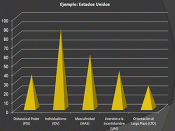Brief Theory Review
There four dimensions are include in the Hofstede's studies (Hill, 2003).
Power distance
In one country, high power distance cultures could let inequalities grow over time into inequalities of power and wealth. By contrast, lower power distance tried to play down such inequalities in society as much as possible.
The individualism versus collectivism
It focuses on the degree the society reinforces individual or collective, achievement and interpersonal relationships. In the individualism society, the ties between individuals were loose and people's achievement and freedom could be valued. Compared with that, in the collectivism society, the relationship between individuals was tight. All the collective types such as family were emphasized by the members.
Uncertainty avoidance
This dimension measured the extent that people with different cultures could place a premium on job security, career patterns, retirement benefits, and so on.
Masculinity versus femininity
It focuses on the traditional masculine work role model of male achievement, control, and power describing the two gender roles and their relationship in workplaces and analyzes the effect on job.
Long term versus short term orientation
It focus on the degree the society embraces, long term devotion to traditional, forward thinking values.
Hofstede's study in China
First, culture is not a constant; it evolves over time. As similar as other countries, Chinese culture is also experiencing its change with the extent of Chinese economic transforming since the end of 1970s (Hofstede, 1994). Hofstsde's was conducted in 1970s that told us in general way about differences between cultures. Many of Hofstede's finding are consistent with standard Western stereotypes about cultural differences. Therefore, it could not totally be suitable for today's Chinese situation.
Second, Hofstede assumes there is a one-to-one correspondence between culture and the nation-state, but, China also has more than one culture as other countries. For...


